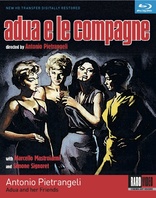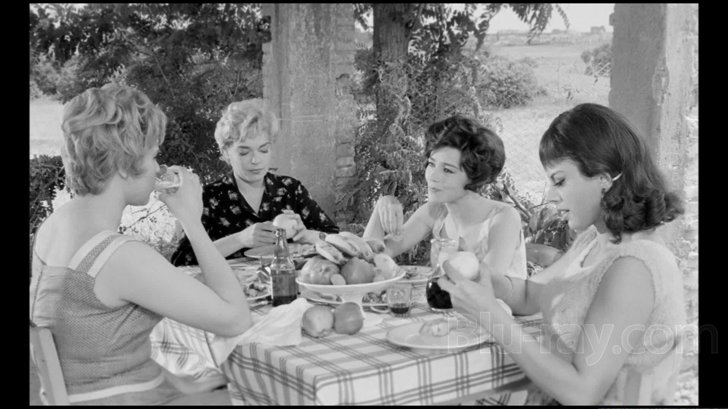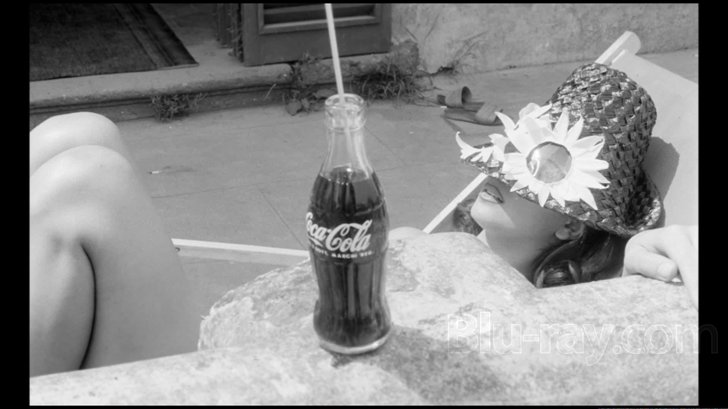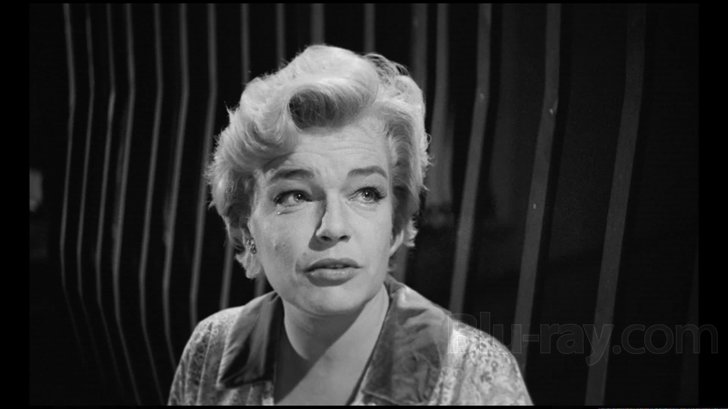Adua e le compagne Blu-ray Movie
HomeAdua e le compagne Blu-ray Movie 
Adua and her FriendsRaroVideo U.S. | 1960 | 129 min | Unrated | Jan 20, 2015

Movie rating
6.9 | / 10 |
Blu-ray rating
| Users | 0.0 | |
| Reviewer | 3.0 | |
| Overall | 3.0 |
Overview
Adua e le compagne (1960)
When a brothel closes because of new laws, four of the prostitutes decide to go into business running a restaurant. They discover they cannot escape their past.
Starring: Simone Signoret, Marcello Mastroianni, Sandra Milo, Emmanuelle Riva, Gina RovereDirector: Antonio Pietrangeli
| Foreign | Uncertain |
| Drama | Uncertain |
| Comedy | Uncertain |
Specifications
Video
Video codec: VC-1
Video resolution: 1080p
Aspect ratio: 1.66:1
Original aspect ratio: 1.66:1
Audio
Italian: LPCM 2.0
Subtitles
English
Discs
25GB Blu-ray Disc
Single disc (1 BD)
Packaging
Slipcover in original pressing
Playback
Region free
Review
Rating summary
| Movie | 4.5 | |
| Video | 3.0 | |
| Audio | 5.0 | |
| Extras | 2.5 | |
| Overall | 3.0 |
Adua e le compagne Blu-ray Movie Review
Reviewed by Dr. Svet Atanasov January 11, 2015Antonio Pietrangeli's "Adua e le compagne" a.k.a. "Adua and Her Friends" (1960) arrives on Blu-ray courtesy of Raro Video U.S. The supplemental features on the disc include a video introduction by Italian film historian Maurizio Poro and a segment from the omnibus "Amori di mezzo secolo" a.k.a. "Mid-Century Loves" (1954). The release also arrives with a 12-page illustrated booklet featuring Bruno Di Marino's essay "Prospectus" and more. In Italian, with optional English subtitles for the main feature. Region-Free.

Adua and her friends
The film opens up shortly after the Merlin Law is passed. (In 1959, the Merlin Law banned the previously legal brothels in Italy and forced thousands of women who worked in them to find new employment. Many of them, however, simply continued working on the streets of the country’s biggest cities). In Rome, four prostitutes -- Adua (Simone Signoret, Casque d'Or), Marilina (Emmanuelle Riva, Hiroshima Mon Amour), Lolita (Sandra Milo, La visita), and Milly (Gina Rovere, Big Deal on Madonna Street) -- decide to open up a small restaurant on the outskirts of the city. With their savings, the women quickly open up an account in a local bank and then apply for a business license.
When their application is denied, Adua, the most experienced of the four women, approaches Dr. Ercoli (Claudio Gora, The Facts of Murder), a shady character with many powerful friends, who agrees to talk to the right people and help them get the business license they need. In return, Dr. Ercoli demands that the women continue entertaining their former clients in the back of the restaurant and pay him a monthly fee.
Soon after, the license arrives and the women get to work -- an abandoned old house is slowly transformed into a small but very stylish trattoria. At first the place becomes popular with the local residents and the workers from a large construction site, and later on wealthier clients start coming in from the city. Convinced that their business plan has worked as intended, the women relax and even allow themselves a bit of old-fashioned romance.
But when Dr. Ercoli recommends the trattoria to a few of his business partners, and they come looking for more than just a good meal, the four women are presented with a difficult dilemma -- should they keep their promise and turn the trattoria into an illegal brothel, or should they reject their shady patron and try to rebuild their lives?
Antonio Pietrangeli’s work is not well known on this side of the Atlantic, but his Adua e le compagne a.k.a. Adua and Her Friends/Hungry for Love is unquestionably one of the very best Italian neorealist films from the 1960s. Indeed, it blends comedy and drama in a manner that very much reminds of Vittorio De Sica and Dino Risi’s best films (the similarity should not be too surprising as the script for the film is from Ruggero Maccari, who collaborated with Risi on many of his best films, including the terrific Il Sorpasso), while its visual style has plenty in common with that of Luigi Comencini and Alberto Lattuada’s films from the same period.
The struggle of the four women to reset their lives is seen from two completely different angles. On one hand, they are seemingly offered a chance to regain their dignity, but as soon as they attempt to reestablish themselves, the society they belong to blacklists them and pushes them in the shadows. They have rights, but not the same rights everyone else does. A very large portion of the film is dedicated precisely to the events that make the women realize that their rights are limited. On the other hand, there are the opportunists who recognize that the women are vulnerable and constantly mistreat them. (Even Marcello Mastroianni’s con artist, who begins a serious relationship with Adua, cannot resist the temptation).
The finale is strikingly cold but honest. It exposes the hypocrisy of a system which most unfortunately still seems determined to punish rather than help women like Adua and her friends rebuilt their lives. (In recent years, former Prime Minister Silvio Berlusconi, a promoter of neo-conservative values, has been involved in a series of highly publicized scandals proving that double standards are very much alive and well in the treatment of commercial sex and sex workers in Italy).
Pietrangeli shot Adua and Her Friends with cinematographer Armando Nannuzzi, who lensed some of Luchino Visconti's greatest films (The Damned, Sandra). The lush jazzy soundtrack was created by the legendary Italian composer Piero Piccioni (Hands Over the City, Camille 2000).
Adua e le compagne Blu-ray Movie, Video Quality 

Presented in its original aspect ratio of 1.66:1, encoded with VC-1 and granted a 1080p transfer, Antonio Pietrangeli's Adua and Her Friends arrives on Blu-ray courtesy of Raro Video.
I've owned four different releases of Adua and Her Friends and from what I can tell Raro Video's Blu-ray release uses as a foundation the old Italian restoration of the film that was initially introduced via the Cinema Forever series. During the DVD era, this Italian release, which was not English-friendly, offered the best technical presentation of the film on the home video market. Unfortunately, the old master apparently has some of that very light scanner noise and sharpening that make a good number of these classic Italian films look a bit harsh when they transition to Blu-ray. The relatively good news here is that the scanner noise is not too prominent and, more importantly, no recent attempts have been made to tone it down with powerful digital tools. (Take a look at Cecchi Gori's release of Seduced and Abandoned to see how poor the end result can be after such corrections). Unsurprisingly, while it is quite obvious that the film could have a far more pleasing organic appearance, it is very much watchable and on larger screens there are actually some quite obvious improvements in terms of detail over the existing R1 DVD release. (Screencaptures #21-25 are upscaled and have been taken from the R1 DVD release mentioned above). Contrast levels remain stable. During the darker sequences, the Blu-ray release also eliminates the macroblocking that is visible on the DVD release. There are no large debris, cuts, stains, or scratches. Overall image stability is also very good. Finally, I noticed quite a few artifacts popping up here and there that could have been avoided with better encoding. All in all, this is undoubtedly the best English-friendly technical presentation of Adua and Her Friends that I have seen, but there is absolutely no doubt in my mind that the film can have a far more convincing organic appearance. Currently, there are simply too many of the typical limitations that we've come to expect from older masters produced in Italy during the DVD era. (Note: This is a Region-Free Blu-ray release. Therefore, you will be able to play it on your PS3 or SA regardless of your geographical location).
Adua e le compagne Blu-ray Movie, Audio Quality 

There is only one standard audio track on this Blu-ray release: Italian LPCM 2.0. For the record, Raro Video have provided optional English subtitles for the main feature.
The audio track is excellent. Depth and clarity are outstanding, and Piero Piccioni's energetic score easily breathes throughout the entire film. The dialog is crisp, stable, completely free of background hiss, and very easy to follow. For the record, there are no pops, cracks, audio dropouts, or digital distortions to report in this review.
Adua e le compagne Blu-ray Movie, Special Features and Extras 

- Introduction - video introduction by film historian Maurizio Poro. This introduction was produced for the Cinema Forever/Medusa DVD release of Adua and Her Friends. In Italian, with printed English subtitles. (7 min).
- Girandola 1910 - Girandola 1910 is a segment from the omnibus Amori di mezzo secolo a.k.a. Mid-Century Loves (1954) which was directed by Antonio Pietrangeli. The remaining four segments were directed by Roberto Rossellini (Napoli 1943), Pietro Germi (Guerra 1915-18), Mario Chiari (Dopoguerra 1920), and Glauco Pellegrini (Romantic Love). In Italian, with optional English subtitles. (11 min).
- Booklet - 12-page illustrated booklet featuring Bruno Di Marino's essay "Prospectus" and more.
Adua e le compagne Blu-ray Movie, Overall Score and Recommendation 

After owning four different releases of Antonio Pietrangeli's Adua and Her Friends, I am fairly certain that Raro Video's Blu-ray release will remain the definitive English-friendly release of this excellent film. Unfortunately, the film can and should look much better on Blu-ray. This being said, if you have already seen the film and are wondering if the Blu-ray release offers any improvements over the old non-anamorphic British DVD release and the more recent anamorphic U.S. DVD release, the answer is yes, it most certainly does. So, even though what we have here is an imperfect Blu-ray release, the film is a minor masterpiece and should have a reserved spot in the library of anyone with even a passing interest in Italian Neorealism.
Similar titles
Similar titles you might also like

Bicycle Thieves
Ladri di biciclette
1948

Il Sorpasso
The Easy Life
1962

I Vitelloni
1953

Reality
2012

Roma
Fellini's Roma
1972

I Knew Her Well
Io la conoscevo bene
1965

La Dolce Vita
1960

Umberto D.
1952

Like Someone in Love
ライク・サムワン・イン・ラブ / Raiku samuwan in rabu
2012

The Great Beauty
La grande bellezza
2013

Il Bidone
The Swindle
1955

Accattone
1961

Christ Stopped at Eboli
Cristo si è fermato a Eboli / Full-Length Version
1979

Three Brothers
Tre fratelli
1981

Mamma Roma
1962

L' Avventura
1960

The Conformist
Il Conformista | 4K Restoration
1970

City of Women
La città delle donne
1980

Amarcord
1973

The White Sheik
Lo sceicco bianco
1952